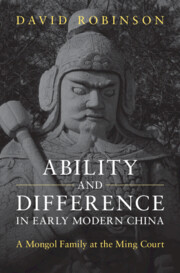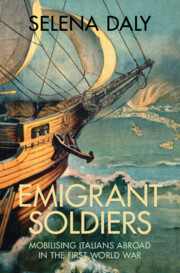Refine search
Actions for selected content:
623 results
Chapter 7 - Novel Subjects
-
-
- Book:
- British Law and Literature in the Long Eighteenth Century
- Published online:
- 19 September 2025
- Print publication:
- 09 October 2025, pp 147-166
-
- Chapter
- Export citation
9 - Turning Every Page
-
- Book:
- Ability and Difference in Early Modern China
- Published online:
- 10 September 2025
- Print publication:
- 11 September 2025, pp 212-230
-
- Chapter
- Export citation
Chapter 12 - Living in a Pause
- from Part I - Storying-to-Learn: How Stories-that-Matter Help Us Appreciate Social Work in Action
-
-
- Book:
- Learning through Social Work Stories-That-Matter
- Published online:
- 28 August 2025
- Print publication:
- 11 September 2025, pp 170-177
-
- Chapter
- Export citation
Conclusion
-
- Book:
- Ability and Difference in Early Modern China
- Published online:
- 10 September 2025
- Print publication:
- 11 September 2025, pp 247-251
-
- Chapter
- Export citation
1 - An Age of Decisions
-
- Book:
- Ability and Difference in Early Modern China
- Published online:
- 10 September 2025
- Print publication:
- 11 September 2025, pp 23-40
-
- Chapter
- Export citation
10 - Seizing Fortune
-
- Book:
- Ability and Difference in Early Modern China
- Published online:
- 10 September 2025
- Print publication:
- 11 September 2025, pp 231-246
-
- Chapter
- Export citation
Introduction
-
- Book:
- Ability and Difference in Early Modern China
- Published online:
- 10 September 2025
- Print publication:
- 11 September 2025, pp 1-22
-
- Chapter
- Export citation

Ability and Difference in Early Modern China
- A Mongol Family at the Ming Court
-
- Published online:
- 10 September 2025
- Print publication:
- 11 September 2025
Community-Engaged Podcasting with Hidden Heroes in a Small Town
- Part of
-
- Journal:
- Public Humanities / Volume 1 / 2025
- Published online by Cambridge University Press:
- 03 September 2025, e132
-
- Article
-
- You have access
- Open access
- HTML
- Export citation
Do Immigrants’ Partisan Preferences Influence Americans’ Support for Immigration?
-
- Journal:
- Journal of Experimental Political Science , First View
- Published online by Cambridge University Press:
- 01 September 2025, pp. 1-12
-
- Article
-
- You have access
- Open access
- HTML
- Export citation
Tilting at Windmills Opportunistically: The Case of Georgian Far Right
-
- Journal:
- Nationalities Papers , FirstView
- Published online by Cambridge University Press:
- 04 August 2025, pp. 1-24
-
- Article
-
- You have access
- Open access
- HTML
- Export citation
No Longer the Only Game in Town? Immigration, Authoritarianism and the Future of Democracy in the West
-
- Journal:
- Government and Opposition , First View
- Published online by Cambridge University Press:
- 30 July 2025, pp. 1-23
-
- Article
-
- You have access
- Open access
- HTML
- Export citation
What Race Am I?: Factors Associated with Racial Self-classification Among U.S. Latinx Adults
-
- Journal:
- Du Bois Review: Social Science Research on Race , First View
- Published online by Cambridge University Press:
- 10 July 2025, pp. 1-22
-
- Article
-
- You have access
- Open access
- HTML
- Export citation
Chapter 11 - US Empire and Latinx Children’s Literature
- from Part II - Transforming Genres
-
-
- Book:
- Latinx Literature in Transition, 1992–2020
- Published online:
- 19 June 2025
- Print publication:
- 03 July 2025, pp 202-218
-
- Chapter
- Export citation
Chapter 7 - The Trouble with Solidarity
- from Part II - Transforming Genres
-
-
- Book:
- Latinx Literature in Transition, 1992–2020
- Published online:
- 19 June 2025
- Print publication:
- 03 July 2025, pp 135-150
-
- Chapter
- Export citation
2 - Roberto Clemente on the Black/Brown Color Line
-
- Book:
- Gift and Grit
- Published online:
- 26 May 2025
- Print publication:
- 12 June 2025, pp 54-84
-
- Chapter
- Export citation

Emigrant Soldiers
- Mobilising Italians Abroad in the First World War
-
- Published online:
- 05 June 2025
- Print publication:
- 26 June 2025
Beyond Observational Relationships: Evidence from a Ten-Country Experiment that Policy Disputes Cause Affective Polarization
-
- Journal:
- British Journal of Political Science / Volume 55 / 2025
- Published online by Cambridge University Press:
- 30 May 2025, e84
-
- Article
-
- You have access
- Open access
- HTML
- Export citation
15 - Immigration and the 100-Year Life
- from Part III - Health, Workforce, and Innovation: The Investments Required for a Healthy Lifespan
-
-
- Book:
- Law and the 100-Year Life
- Published online:
- 13 May 2025
- Print publication:
- 29 May 2025, pp 203-215
-
- Chapter
-
- You have access
- Open access
- HTML
- Export citation
Americans’ Perceptions About Immigrants from Different World Regions: Evidence from a Multinomial Conjoint Experiment
-
- Journal:
- Journal of Experimental Political Science , First View
- Published online by Cambridge University Press:
- 19 May 2025, pp. 1-11
-
- Article
-
- You have access
- Open access
- HTML
- Export citation
